At Make Real, we’ve been working with the construction, energy and utilities sectors (which we collaboratively call Built Environment) for over 10 years. With deployments across the globe, we’ve creating immersive learning experiences and training simulations for some of the largest organisations. We have worked with all the available technologies, appropriately falling out of a particular solution, rather than driving them, from multi-channel projection screens, CAVEs, motion platforms, Virtual Reality (VR), Augmented Reality (AR), mobile, tablet and headset-based devices.
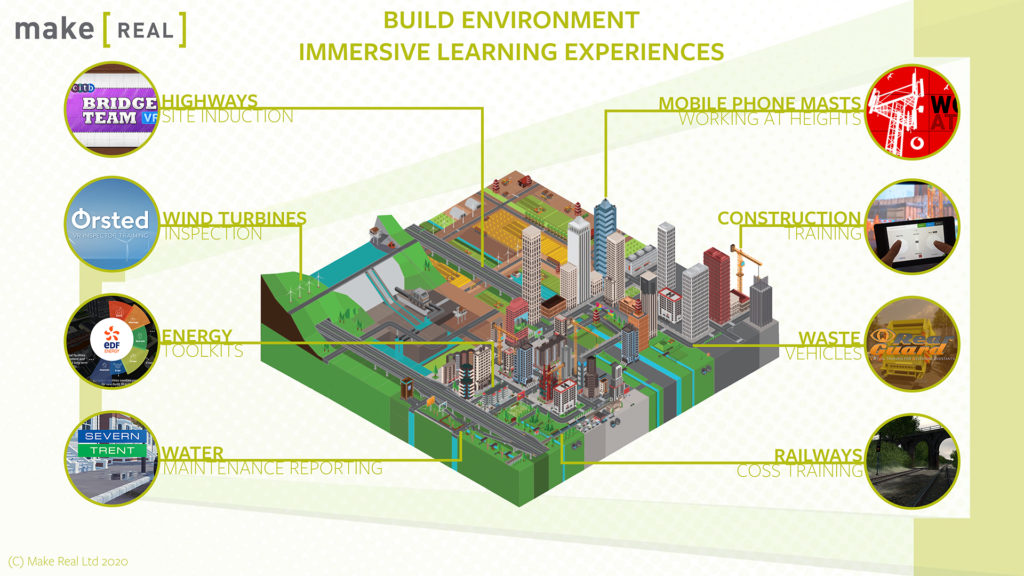
There are a range of use cases for immersive technologies within the construction sector, many of which we have created either as a prototype, a deployed pilot or fully scaled solution. Some are outlined below:
Here we take a look at some of the key developments and processes behind them, in order to provide a better understanding of what is possible with the range of immersive technologies.
Our initial projects around construction training required warehouse spaces, expensive projectors linked over a multi-channel networked system and 10m+ parabolic screens. This provided a sense of immersion through sheer scale, whilst enabling high volumes of trainee throughput. Two of these centres can be found in Coventry University at the (formerly) Act-UK Centre (now ACUA) and at the Building Leadership Simulation Centre (BLSC) in Melbourne, Australia. Both of these installations were based upon an initial concept devised and deployed in the Netherlands previously.
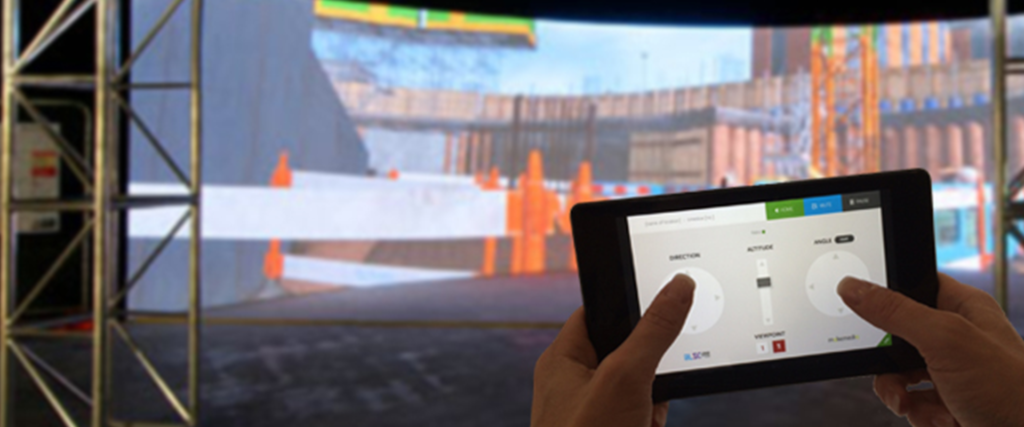
Through a “mixed reality” of 3D scenes, or timeslices as we called them, live actors and site assets like portacabins and phone systems, construction site trainees were run through a series of scenarios related to a range of aspects of onsite health, safety and well-being and management. Five timeslices per location were created by hand, modelling to reflect real world construction sites across enterprise, commercial and residential developments. Each timeslice was modelled based upon real world data provided from onsite to Make Real, through photos, CAD and BIM, to ensure 100% accuracy and the smallest of details.
From a technical operations and costs perspective, the initial simulation hardware has been upgraded and replaced from multiple high-end Windows-PCs driving each of the 4K projectors, running an annual subscription of full-flight simulation software Presagis Vega Prime, to a single high-end gaming PC with multi-channel support baked into the Unity 3D engine, removing the need for ongoing software license costs. This has also enabled other uses of the simulation system to emerge, including 360º photo and video playback as cameras become more prevalent on more recent sites, for inclusion into training scenarios.
Since opening in 2014, the BLSC has welcomed thousands of construction site trainees through the programme, reporting up to 90% reduction in OSI (On Site Incidents) as a result, as well as being indirectly attributed to reduction of construction costs up to 5% and improvements to construction quality up to 10%.
Benefits:
Sometimes it is not required to create a giant simulation centre for providing immersive training materials related to less physical tasks and activities. This is when a desktop trainer solution is beneficial, providing a level of immersion and access to 3D data without the need for a VR headset or multi-channel display setup.
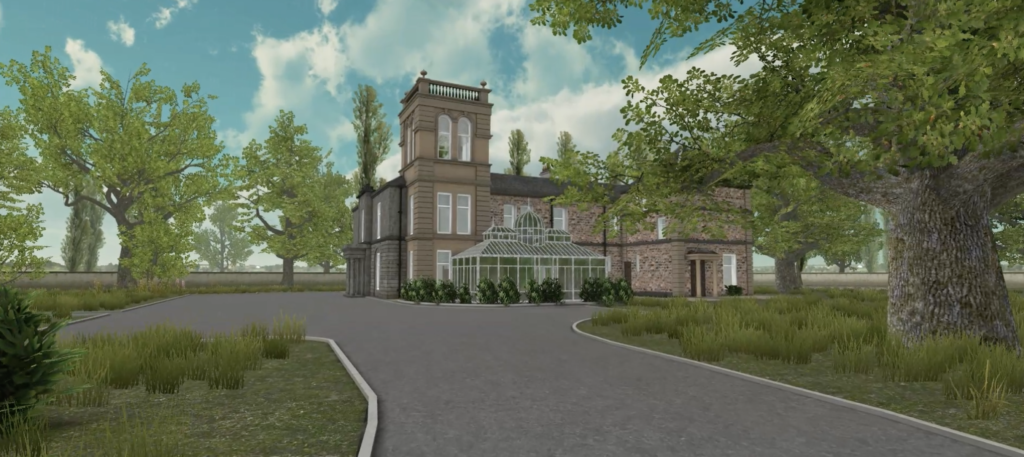
Working with CIOB (The Chartered Institute of Building), we created a series of 3D representations of real-world buildings and future visualisations. Based upon actual plan data, the purpose was to enable trainees to explore and train around site planning and building inspection report creation. Without requiring onsite access to physical locations, cost of training was reduced through not needing to travel or ensure safety of sites. Sites could then be virtually replicated at relatively low-cost and used throughout the country across multiple training centres or offices. Training outcomes enabled the learners to travel through time and visit the site pre- and post-construction phases as part of their report generation training.
Benefits:
It should be noted that since the original deployment, this type of content can easily be created to be viewed within an internet browser without the need for 3rd-party plugins or standalone applications, to be hosted either locally on a PC, within an organisation or online for remote access.
One of the key benefits of virtualisation of construction sites, buildings and assets is that once the 3D models have been created, they can be utilised multiple times across a range of devices with little to no additional work effort required. (Caveat: CAD often needs to be heavily optimised initially for use).

When working with EDF Energy across a suite of training applications and experiences around the Hinkley Point C (HPC) construction site and development, 3D models have been re-used and re-purposed, reducing development time and costs. From desktop to mobile to tablet to VR and AR experiences, the same models have been incorporated, or only needed to be refreshed or updated once and re-applied across the suite of applications.

Similarly the project with CITB, BAM Nuttall and Highways UK saw re-purposing of film and interactive 3D content being used across desktop, tablets and mobiles and VR headsets. This enabled cost reductions associated with content creation and a wider scale of access to materials depending upon use case, location and purpose.
Benefits:
We often state that immersive technologies are most effective when they are incorporated as part of a blending learning approach. This is when they are used to enhance and expand methods of learning that perhaps fall short through traditional means of delivery. Learners benefit by allowing greater interactions with existing and refreshed content, rather than using immersive technologies to completely replace existing methodologies and content.
We have created learning experiences for EDF Energy and Severn Trent that take existing systems, such as reporting applications and real-world ToughPad hardware, and virtualise them into the simulation. This reduces access requirement but also allows the learner to explore and familiarise themselves with the systems at their own pace. Including the real-world systems in the simulation also increases the realism and accuracy of the training, merging real and virtual into scenarios.

For EDF Energy this was the complex application used by smart meter installation engineers, tracking customer information, job and task details and associated data around residential property visits. By recreating the system virtually, training data could be tracked separate to the real customer data, requiring no cleaning of errors whilst also removing need to take the devices away from the working installation engineers.
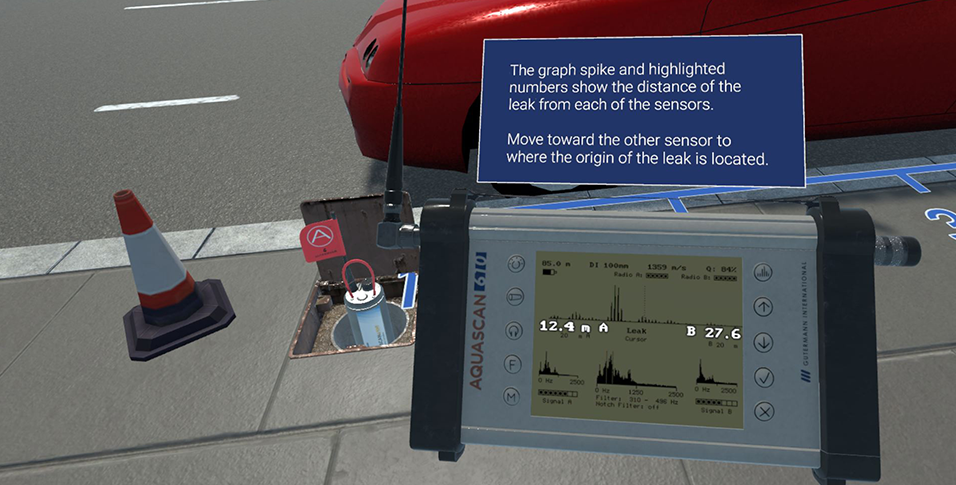
For Severn Trent, the virtual ToughPad was once more incorporated to allow training around water leak resolution, allowing site reports creation training to take place, including advanced features such as correct placement of maintenance task iconography for the ground crew to refer to and realtime photos of the scenario to be captured and added to reports.
Benefits:
Thanks to the motion tracked input controllers with [6DoF] VR headsets, many training applications can take advantage of gesture-based input to accurately reflect real-world hand signals and motions required onsite and/or on the job. From guiding reversing large vehicles down virtual side streets, avoiding potentially fatal damage to persons and property, to assisting vehicle access onto, around and off site, to communicating to crane operators to manoeuvre loads around sites, hand gestures are used in a range of construction tasks.

Until this virtual system, much training has had to take place through video content or sectioned-off areas of a site, removing access to vehicles and cranes that would be better served carrying out the tasks necessary efficiently without incurring additional usage costs. By carrying out the training virtually using tracked hand signals and gestures, learners can train anywhere and carry out multiple repetitions without impacting throughflow of learners or exceeding a given short access time onsite.
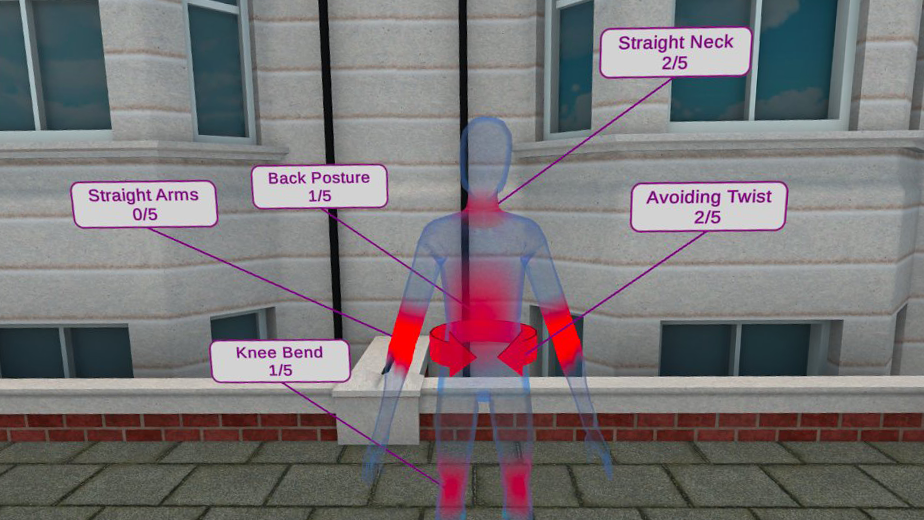
However more than just hands can be tracked, meaning body position and feedback can be provided around posture-based tasks, from lifting manhole covers and other heavy objects onsite or even virtual people. Severn Trent reached out to Make Real to complete a series of manhole cover lifting training scenarios using our posture tracking system, further enhanced by virtual day and night time environments to provide a wider learning experience.
Benefits:
As mentioned, VR provides benefits around enabling access to dangerous activities safely, or enabling a scale of access to physical assets. For example, telecommunication towers are a dangerous asset to access without the proper training, and the training poles are few and far between across the country.
For Vodafone we created a prototype experience that explored the validity of using VR for training around working at height. Another purpose of the prototype was to explore the use of motion tracked input controllers and virtual hands replicating the experience of climbing a pole, following safe and unsafe procedures. The final purpose was to engage with the various stakeholders internally at Vodafone to bring them onboard for a wider piece of work.
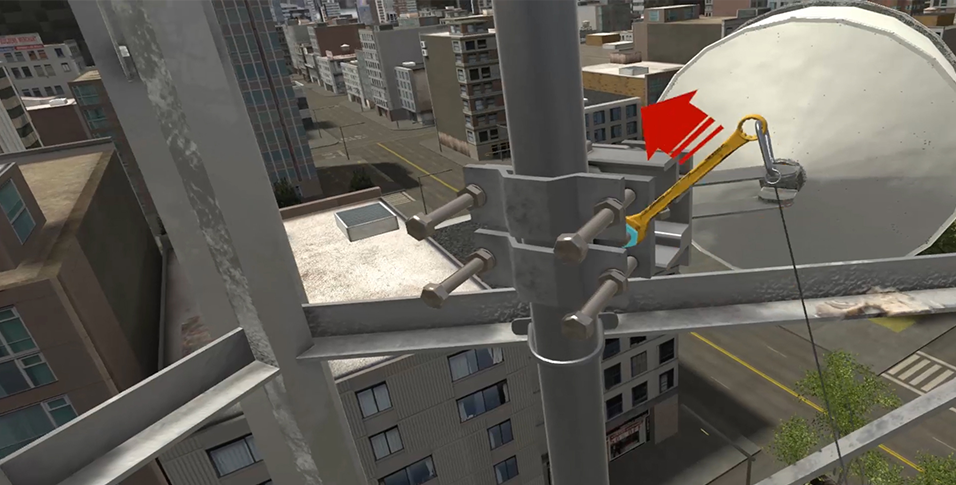
The prototype was successful, almost too successful as we saw user after user becoming physically frozen in-space, as they were immersed so deep up the virtual pole. The resulting full application saw the design amended to provide relevant learning outcomes and experience without creating a completion blocker. The finished experience was designed across three tiers of delivery, from “full VR” to mobile VR to an interactive screen-based 360º version deployed across the Vodafone university LMS. By monitoring employee movement across Europe, the full VR version was deployed into four key HQs, capturing 80% of all staff over a year. The mobile VR version was deployed as a loaner, take-home kit for self-study and experience. The experience itself was aimed at increasing maintenance crew manager empathy for their teams as part of a wider organisational focus on reducing fatalities, as part of their “Work Safe, Home Safe” campaign.
From being up high to being deep underground, we worked with CITB and Tunnelskills to create a suite of learning experiences in VR around the dangers of working in tunnels. Once more, tunnels are a dangerous environment with high-levels of training required around health & safety procedures but are also a unique sensory experience for humans to adapt to. By filming 360º video for playback in VR headsets and creating a series of 3D experiences around emergency procedures, learners are able to experience what being in a deep underground tunnel with noisy machinery, limited space and training scenarios that would not be viable to recreate in the real world.
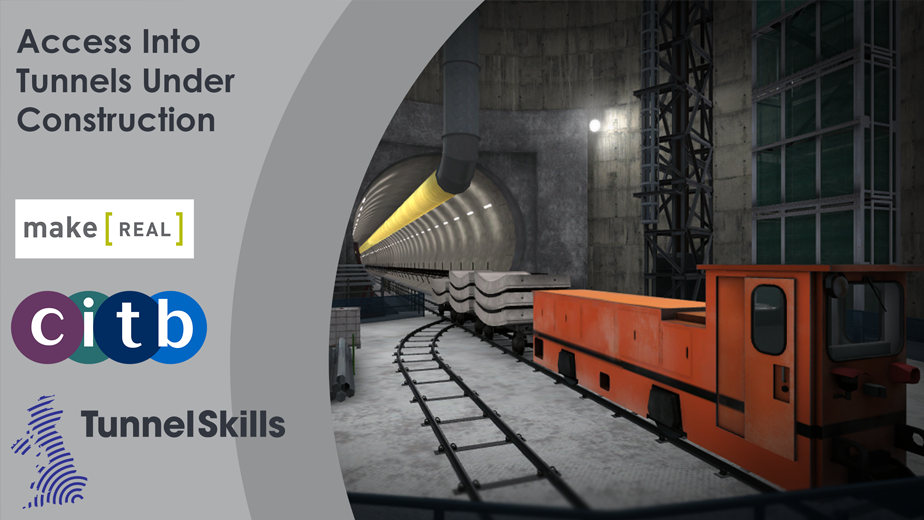
Benefits:
It’s no shock to anyone that the future workforce and employees entering construction today are looking for more immersive and engaging training and technology uses within their every day-to-day tasks. The CITB report covers this in great depth, leading to our projects with BAM Nuttall and Highways UK and also Tunnelskills, mentioned already above. Similarly, there are many reports into how gamification can enhance and improve training through increased engagement and learner connection to the content.

For the CITB / BAM Nuttall / Highways UK project, we created a VR gamified experience to bring the learning together at the end of the training, to allow the learners to practice their understanding of the knowledge gained. Bridge Team VR is an asymmetrical game designed around planning, constructing, building and placing a new bridge. The VR learner has to carry out the processes as described to them by the non-VR learners, who hold clue cards with the relevant information and data upon them. By working together they are able to successfully complete and enjoy the bridge view in VR.
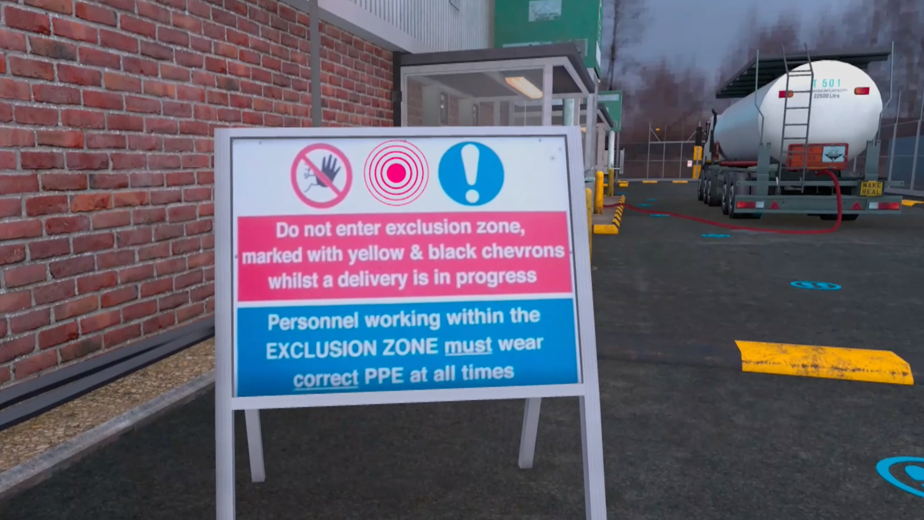
Whilst not construction, we created an investigative asymmetrical experience for Severn Trent, around chemical deliveries and operations. Taking turns to investigate clues within the virtual environment crafted around a water treatment plant in VR, combined with Windows PC or tablet-based assessment tools, the learners would uncover the steps undertaken by various operatives which resulted in the incident.
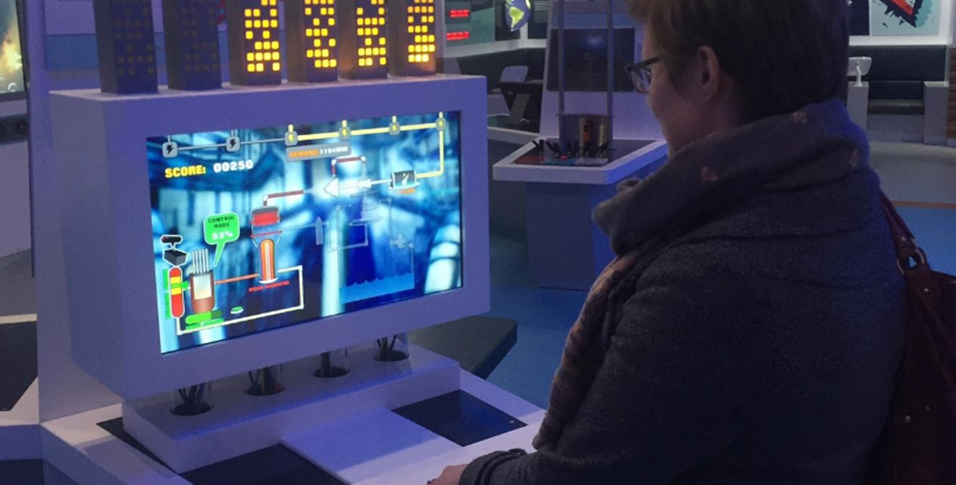
Still on the topic of energy and utilities, as part of the content deployed into their new digital centre of learning excellence at Cannington Court, we created a team-based tablet game, “Reactor Runner“, for learners to take on roles within a nuclear power station to maintain operations whilst meeting market demands on power. This took on a life of its own as it was adapted from a multi-user tablet experience to a single-user physical installation, now in use at Glasgow Science Centre and the new EDF Energy Cannington Court HPC Visitor Centre, opening in 2021.
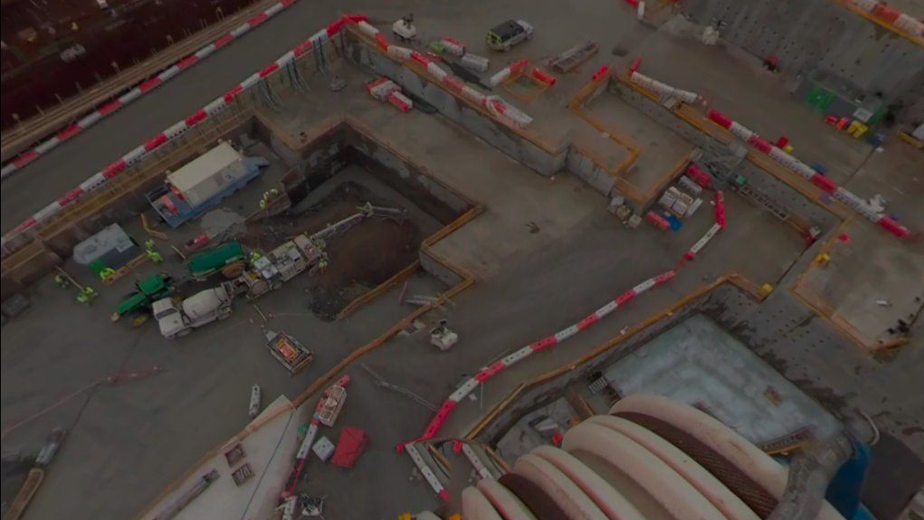
Not all forms of onboarding have to be fully interactive however. Working with BAM Nuttall once more, we filmed a series of 360º videos across key UK construction sites to highlight aspects of site work, process and to provide a sense of life within the sector. Whilst lower cost to create, there’s just as many challenges involved, like hoisting our precious 360º camera up high on Big Carl, the world’s largest crane.
Benefits:
One benefit of training using VR and virtual representations of assets and materials, is to reduce the amount of real world physical materials used during training. VR simulations can be created to provide physical skills training with virtual materials and 1:1 hand interactions, to get trainees to a level ready for assessment. Real materials would likely still be needed for assessment, however by doing so, materials are not wasted whilst getting trainees to that level. This helps reduce wastage but also cost of training, and allows for more repetitions of training scenarios, since they are all virtual.
An example of this is the LV Jointing VR simulation we created for UK Power Networks. As a result of using the training tool, apprentices have used significantly less physical cable in their learnings as they prepare to get assessment ready. At the point of assessment, they will use physical cable but only a fraction of what was being used previously during training prior to that point.
On a much larger scale, this can be true for site assets and plant machinery too. By replicating oversize vehicles or site areas within scenarios, access to these often costly machines is reduced, meaning they can continue to remain in operation efficiently. Similarly, by creating realistic virtual environments to position the learner within, yards or areas of the real world construction site do not need to be sectioned off and taken out of use for training. When there is a direct impact upon revenues generated by large scale assets being in use as intended, training cost savings are generated through maintaining intended use, rather than taking them out of action. Training time and logistical complexity of organising real world assets to be at a training centre is similarly reduced.
Benefits:
Training and certification is important in any industry but especially construction, where improper or ineffective training can prove fatal onsite. Through our work with various construction organisations, we have always understood the importance of validating use cases for immersive technologies within training. Through our partnership with Keltbray, we decided to create a tool to enable recording, review and recall of VR training, called Skill Shield.
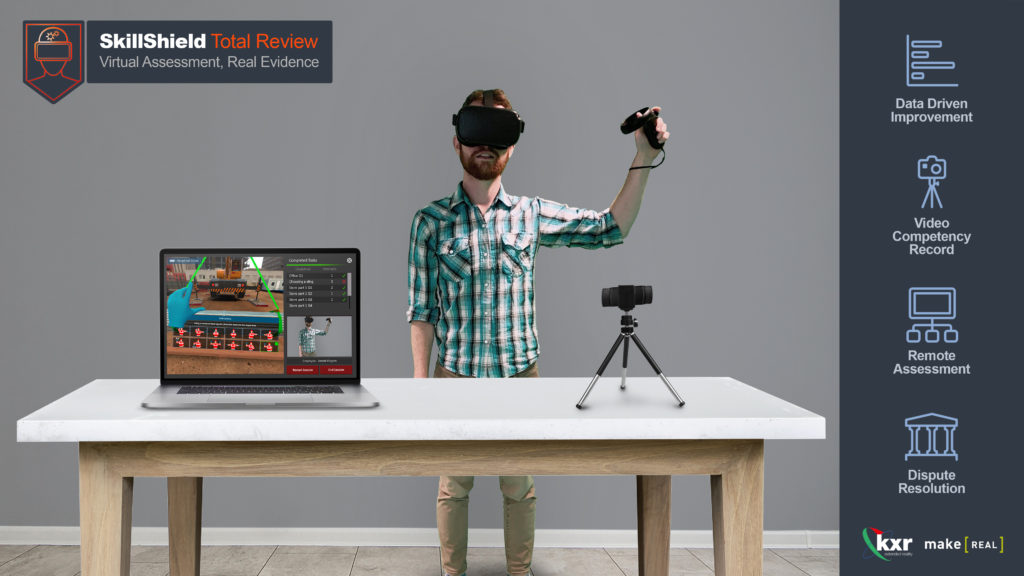
The purpose of Skill Shield is to overcome a number of technical challenges and auditing objectives for training using VR within the construction sector. Using a standalone VR headset, trainers and facilitators are not always able to cast a live stream of the experience to see what the trainee is seeing and doing. Skill Shield addresses this by creating a local network video feed from VR headset to a Windows laptop over a WiFi router. Furthermore, video evidence of the trainee completing the training is often required at time of OnSite Incident. Skill Shield uses a webcam in the Windows laptop to capture footage of the trainee carrying out the VR training in physical space. To complement the evidence factor, the trainee training details are stored as part of the video file frame and metadata. Finally all the learning outcomes are tracked and displayed as they are completed by the trainee.
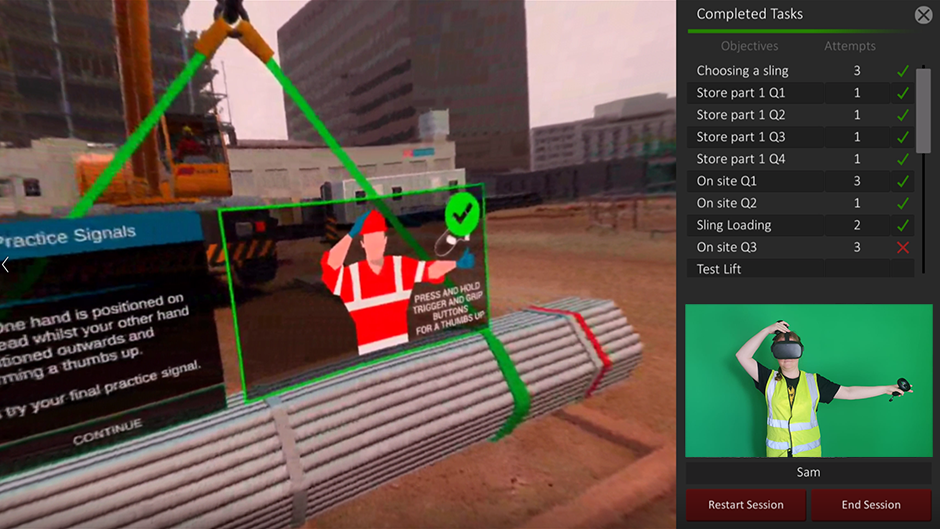
These four elements are composited together into a single, unified, irrefutable video learner record for storage and audit at a later date as necessary. This video record can also be scrubbed through and used as assessment feedback and for review immediately after the training session. As the composite single video capture is created in realtime on the Windows laptop, it can also be live-streamed externally if necessary, allowing remote facilitation and external review during the training session, if all participants are unable to co-located together physically within the same space for any reason.
A number of VR training applications for construction are already compatible with Skill Shield or 3rd-party content can have the functionality added via a Unity plugin available.
Benefits:
As covered above, there are many use cases for incorporating immersive technologies into training across all sectors within the construction industry. From onboarding to site training with specific assets and processes, to general health, safety and wellbeing, each solution is carefully considered for the outcomes required. Whilst development costs can range from £50,000 to £250,000+ depending upon the length, complexity and purpose, once the training is deployed at scale across an organisation, the benefits become apparent more clearly. Reducing cost of training, improving training outcomes, or assessment rates, to encouraging new candidates into the industry and validating their training once it has occurred, many benefits and advantages can be achieved.
With over a decade of experience creating immersive training experiences for the construction industry and wider energy, utilities, telecommunications and transport sectors, we have been showcasing effective solutions and improving learner outcomes across the board. Get in touch today to discuss how you can enhance your offerings and engage your crews.
We’re always happy to talk to you about how immersive technologies can engage your employees and customers. If you have a learning objective in mind, or simply want to know more about emerging technologies like VR, AR, or AI, send us a message and we’ll get back to you as soon as we can.